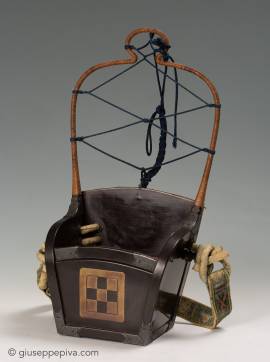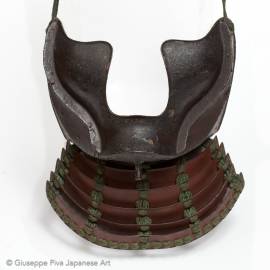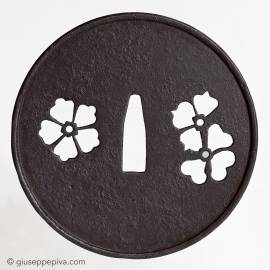EbiraSamurai open quiverMid Edo period, 17th-18th centuryHeight: 35 cm This black lacquered antique ebira is decorated on the front side with a gold lacquer family crest (kamon) with ishidatami (paving stone) design. High quality level engraved metal kanamono have been applied to decorate and protect all corners and borders.The back side is covered with stenciled dear skin and a belt made of same leather is tied to the sides.On this page is a comprehensive glossary of common terms related to samurai armor.Ebira for sale. Price on application. Please include item stock number:...
WORKS FOR SALE
Late Muromachi Period (1336-1573)16th centuryA rare samurai mask of hanbo shape, covering half face and excluding the nose.The narrow size of the nose aperture immediately suggests a very old date, confirmed also by the iron and laquer consumption, which help to date the item to the 16th century.The general shape of the mask, together strong but delicate, is very similar to a model drawn in the Meiko-zukan-zokushu signed by Yoshimichi and to the hanbo signed Takayoshi in the Orikasa collection: the curled lip and the well balanced lines follow the same design,...
Mid Edo Period (1615-1868) 18th Centuryron with openwork decoration (sukashi)96 mm, maru-gata with beveled raised rim (takadotemimi)Thickness at the seppadai: 3 mm. Thickness at the rim: 6 mmA karabana flower on one side and a kikyo over a sakura on the other create a well-balanced composition. The delicate subject, careful finish and refined iron indicate a tsuba of high quality.Karabana design had been imported from China and do not resemble any real Japanese flower; this indicates that the decoration is actually referring to family crests and not to natural...
Copyright © 2016 - giuseppe piva - VAT: 05104180962










